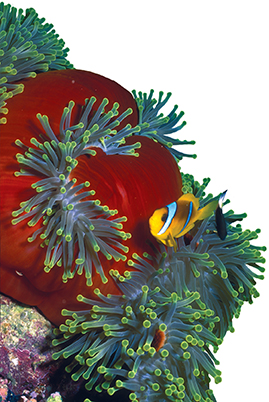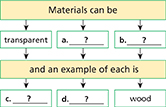18.3 Behavior of Light
Reading Focus
Key Concepts
 What three types of materials affect the behavior of light?
What three types of materials affect the behavior of light? How does light behave when it enters a new medium?
How does light behave when it enters a new medium?
Vocabulary
transparent
translucent
opaque
image
regular reflection
diffuse reflection
mirage
polarized light
scattering
Reading Strategy
Monitoring Your Understanding Copy the flowchart below. As you read, complete it to show how different materials affect light.
What would you see if you were snorkeling in warm ocean waters over a coral reef? You might see fish of bright colors, clown fish, sea stars, sponges, and clams. You might see sharks or turtles, and of course, coral. But why can you see these animals so clearly? Why can you see the reef through the water but not, for example, through the bottom of the boat that brought you to the reef?
Light and Materials
Without light, nothing is visible. When you look at the reef animals, what you are really seeing is light. You can see the reef through the water, because light passes through the water between the reef and your eyes. But you can't see the reef through the bottom of the boat because light doesn't pass through the boat.
How light behaves when it strikes an object depends on many factors, including the material the object is made of.  Materials can be transparent, translucent, or opaque. Each type of material affects the behavior of light in different ways.
Materials can be transparent, translucent, or opaque. Each type of material affects the behavior of light in different ways.
A material through which you can see clearly is transparent. A transparent material transmits light, which means it allows most of the light that strikes it to pass through it. For example, the water where the fish and coral in Figure 16 live is transparent. While riding on a bus, you can see buildings and trees outside because the bus windows are transparent.
Figure 16 Water is transparent. You can see through it. That characteristic makes it possible to photograph these fish and other animals living in the ocean.






